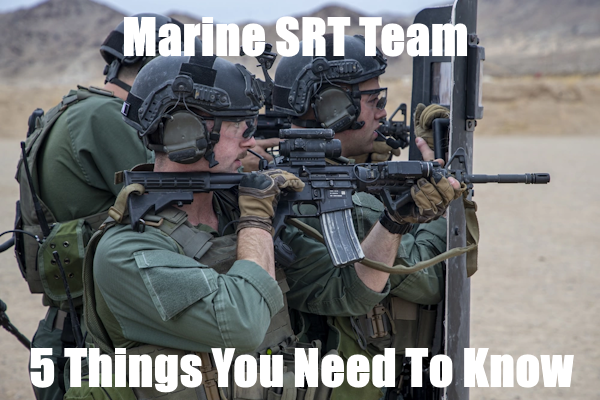Marine SRT is an elite group within the service branch.
The Special Reaction Team (SRT) is composed of highly trained military police officers.
These Marine officers are equipped to respond to active shooter and hostage situations, along with the rescue of barricaded suspects.
Learn more about what it takes to join Marine SRT, including job requirements, team organization, and training.
Related Article – Marine Special Forces: 10 Elite USMC Units
Table of Contents
Marine Corps SRT: 5 Things to Know
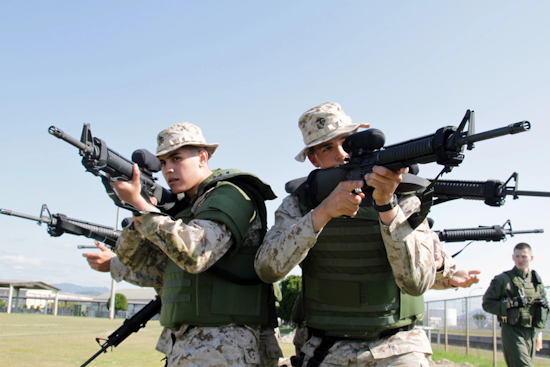
The United States Marine Corps (USMC) features many different specialized groups and units.
As a result, a Marine SRT (Special Reaction Team) is one of those advanced units.
In general, SRT Marines serve as military police officers trained to handle dangerous or life-threatening situations.
Marine SRT teams respond to hostage situations along with active shooters with barricaded suspects.
These military first responders are assigned the important task of keeping military bases and installations safe.
For this reason, there are several things you should know about Marine SRT including:
- Purpose
- Requirements & Qualifications
- Marine SRT Organization
- Weapons & Gear
- Marine SRT Training
In general, Marine SRT responds to situations that are too chaotic or dangerous for a typical military police officer.
Special Reaction Teams are stationed at Marine Corps installations in the Provost Marshall’s Office (PMO).
The security office also provides support for traditional military police officers and Department of Defense (DoD) civilian employees.
Discover more things you should know about Marine SRT including purpose, requirements, weapons, team organization, and training:
#1. Purpose
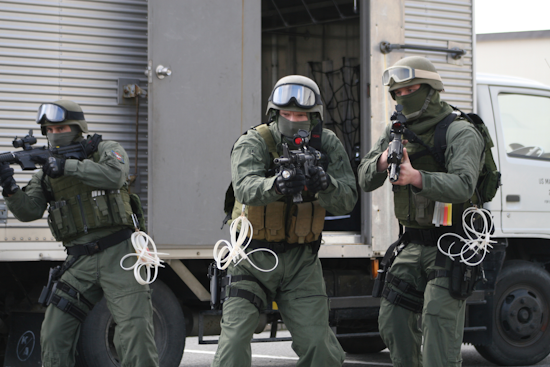
The Marine Corps Special Reaction Team (SRT) is an advanced group of highly trained military police officers.
These elite police officers provide security for the Marine Corps at military bases and installations.
Often, many consider Marine SRT the equivalent of military S.W.A.T. Teams.
Accordingly, Special Reaction Teams are extremely well trained (more details, below) and can respond to a variety of risky or dangerous situations.
A Marine SRT is equipped and responds to active shooter and hostage situations.
Furthermore, these first responders are also trained for other emergency situations, including embassy takeovers or evacuations.
A Marine SRT must remain prepared for a wide range of crises including terrorist attacks and barricaded incidents.
Additionally, Special Reaction Teams often provide security and VIP protection for important people and assets.
In general, Marine SRT teams consist of anywhere between 7 to 14 military police officers.
The Provost Marshall’s Office (PMO) is responsible for assembling and training police officers for this role.
Consequently, the Marine Corps PMO usually selects the best and most advanced military police officers for Special Reaction Teams.
Marine Special Reaction Teams are considered a multi-task force, which means they must be prepared and ready for a wide variety of emergency situations.
As such, these team members are cross-trained in numerous duties and scenarios, including providing fire support and clearing buildings.
Related Article – National Guard Military Police (MOS 31B): Career Details
#2. Marine SRT Requirements
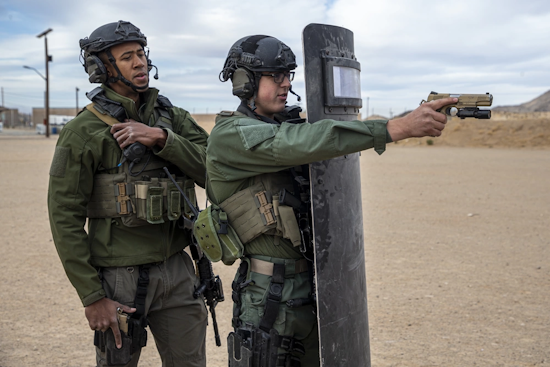
Marine Special Reaction Teams (SRT) are comprised of traditional military police personnel.
The Provost Marshall’s Office (PMO) selects candidates they deem worthy of having the skills and competence to be part of the team.
Additionally, eligible team members must meet the following requirements:
- Marine Corps Police Officer (MOS 5811) in the service branch.
- Obtained the military rank / pay grade of Corporal (E-4) or higher.
- Must volunteer for SRT service.
- Possess a high degree of maturity and self-control.
- Maintain minimum first-class physical fitness standards.
- Qualify as an “expert” with service rifle and pistol.
- Graduate from Special Team Course, U.S. Army Military Police School.
In general, team members are cross-trained in all team duties to maintain a fluid and well-organized team.
Special Reaction Teams are trained to isolate a crisis incident, provide marksmanship and direct fire support, as well as conduct tactical movement and building entry.
There are similar job ratings in the Marine Corps, including becoming a member of Marine FAST or Marines Close Quarters Battle (CQB) teams.
#3. Marine SRT Organization
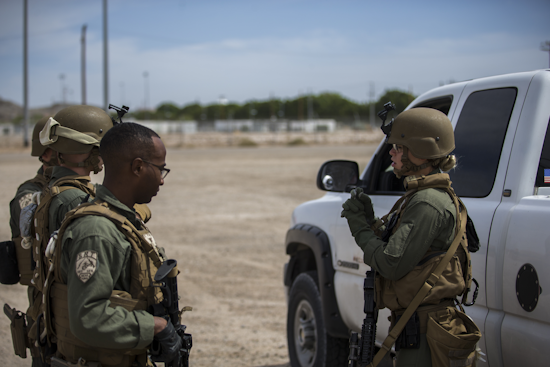
The organization of Marine Special Reaction Teams is crucial to the success of any mission.
Accordingly, Marine SRT teams spend much of their time preparing and staying organized.
In general, the size of the team may vary, yet usually consists of between 7 to 14 members.
The organization of the military police unit is very comparable to traditional S.W.A.T. units.
As a result, a typical 9-man Special Reactions Team consists of the following elements:
Marine SRT Entry Element
The entry element is the first to enter a chaotic or dangerous scene.
At a minimum, it consists of the following team members:
- Team Leader
- Pointman
- 1st Defenseman
- 2nd Defenseman
- Rear Security
The Marine SRT Team Leader organizes and supervises all team activities including mission planning and training.
Secondly, the Pointman in Marine SRT conducts recon and suggests primary or alternative routes to reach a target.
Furthermore, the Pointman may lead the rest of the team members throughout various phases of the operation.
Third, the 1st and 2nd Defenseman are responsible for providing security and protection for the Pointman.
Additionally, these team members also transition into Pointman whenever the team splits (or whenever else is necessary).
Finally, the Rear Security provides back cover and other important forms of protection during a military exercise.
Then, in addition to those 5 team members, a traditional 9-man team also consists of the 2nd entry element (or cover element).
Marine SRT Cover Element
The purpose of the 2nd entry element is to provide cover and fire support for the first entry element.
In general, it consists of at least the following team members:
- Marksmen (2)
- Observers / Recorders (2)
The Marksmen provide surveillance and fire support from a fixed position.
These SRT members may relay information to the team leader or neutralize targets, depending on the situation.
Meanwhile, Observers and Recorders are also referred to as “spotters.”
As the name implies, these individuals are important observers who relay important information back to Team Leaders and fellow Marksmen.
They also serve to collect and provide evidence for possible legal prosecution.
Despite the team organization, SRT members are trained and equipped to serve in any role.
Thus, team members receive cross-training in every position and role on the security team.
In general, Special Reaction Teams are described as small, tight-knit groups that are very well-trained and prepared for a variety of scenarios.
Therefore, the application and selection process for Marine SRT is considered very competitive.
Related Article – How To Become A Marine Corps Police Officer
#4. Weapons & Gear
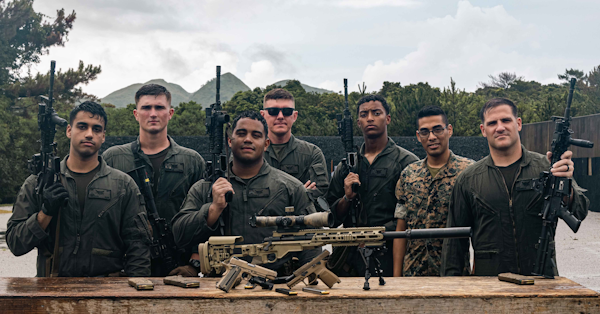
Marine SRT relies on a variety of weapons and gear to complete any mission.
Thus, the typical weapons used by Special Reaction Teams include:
- M4 Carbine
- MP5 Submachine Gun
- M9 Pistol
- M45 CQB Pistol
- M1014 Semi-Automatic Shotgun
- MK11 Sniper Rifle
Again, since Marine Special Reaction Teams are cross-trained, they must be able to fulfill the functions and responsibilities of each role.
For this reason, SRT Marines are trained to handle a variety of weapons and gear.
The typical Marine SRT arsenal includes an M4 carbine, M1014 shotgun, M9 and M45 pistols.
Furthermore, Special Reaction Teams also incorporate numerous specialized equipment into their arsenal, just like civilian S.W.A.T. teams.
These include ballistic shields and stun grenades, along with protective gear like Kevlar helmets, fireproof coveralls, and body armor.
Marine SRT units are constantly evolving and training with new weapons and gear that may be suitable for the mission.
#5. Marine SRT Training
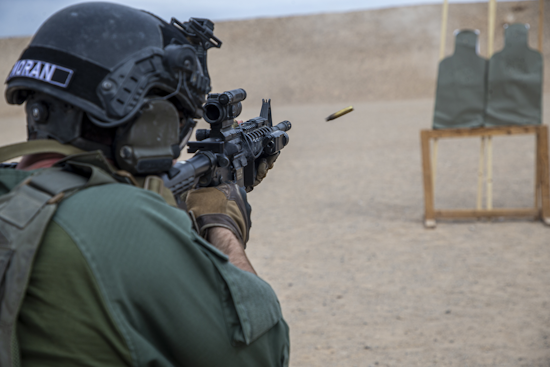
The Marine Corps Special Reaction Team is no different from other SRT teams in different branches of the U.S. Armed Forces.
Marine SRT candidates must attend the U.S. Army’s Military Police Special Reaction Team course.
The training course takes place at the Army Military Police School in Fort Leonard, Missouri.
Marine SRT training consists of 2 different phases:
- Phase I: Focuses on the skills required to serve on the entry team
- Phase II: Focuses on the skills needed to serve as a Marksman / Observer.
The Marine Corps understands that high-risk emergencies and other dangerous situations can occur at any moment.
Therefore, Special Reaction Teams are trained and equipped to handle a variety of scenarios, including terrorist attacks and hostage situations.
Marine SRT units are always on standby and ready to react in the event of an active shooter or barricaded subject.
Generally, the team responds to incidents that are classified as too high-risk or dangerous for a military patrolman.
Here’s an example of the type of training you can expect becoming a member of Marine SRT:
Marines who serve in the S.W.A.T. equivalent of the military police conduct weekly training exercises.
Often, these include range firing and organized team tactics, along with other specialized training.
Ultimately, SRT teams prepare and train to save lives and ensure the military installation is safe from outside obstructions.
Related Article – ASVAB Scores For Marine Corps Jobs
Conclusion
Emergencies occur at any place or moment.
For this reason, the Marine Corps established its own form of a S.W.A.T. team known as Marine SRT.
Marine Special Reaction Teams (SRT) respond to a variety of emergency and dangerous situations.
These include active shooter and hostage situations as well as barricaded and rescue operations.
As such, Marines cross-train to learn all roles and functions within the team, including serving as a Pointman or Marksman.
Marines are constantly training in different exercises and with various weapons and gear.
The advanced training allows Marines to become proficient and skilled in several different aspects of the security team.
- Replacing Dog Tags: 6 Things You Need to Know - June 28, 2024
- Navy OAR Test Study Guide - June 24, 2024
- 10 Best Sniper Movies of all Time - June 20, 2024
Originally posted on August 14, 2023 @ 6:11 pm
Affiliate Disclosure: This post may contain affiliate links. If you click and purchase, I may receive a small commission at no extra cost to you. I only recommend products I have personally vetted. Learn more.
